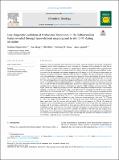Files in this item
Late diagenetic evolution of Ordovician limestones in the Baltoscandian basin revealed through trace-element mapping and in situ U–Pb dating of calcite
Item metadata
| dc.contributor.author | Hagen-Peter, G. | |
| dc.contributor.author | Wang, Y. | |
| dc.contributor.author | Hints, O. | |
| dc.contributor.author | Prave, Anthony R. | |
| dc.contributor.author | Lepland, A. | |
| dc.date.accessioned | 2021-11-05T17:30:21Z | |
| dc.date.available | 2021-11-05T17:30:21Z | |
| dc.date.issued | 2021-12-20 | |
| dc.identifier | 276567480 | |
| dc.identifier | 34d409e8-842b-4bcd-9446-cfdb2e995a7c | |
| dc.identifier | 85117711099 | |
| dc.identifier | 000712225100002 | |
| dc.identifier.citation | Hagen-Peter , G , Wang , Y , Hints , O , Prave , A R & Lepland , A 2021 , ' Late diagenetic evolution of Ordovician limestones in the Baltoscandian basin revealed through trace-element mapping and in situ U–Pb dating of calcite ' , Chemical Geology , vol. 585 , 120563 . https://doi.org/10.1016/j.chemgeo.2021.120563 | en |
| dc.identifier.issn | 0009-2541 | |
| dc.identifier.other | RIS: urn:EA50D56915FF9BE987B69EC1FC72B3FC | |
| dc.identifier.other | ORCID: /0000-0002-4614-3774/work/102725135 | |
| dc.identifier.uri | https://hdl.handle.net/10023/24270 | |
| dc.description | Funding: supported by the Research Council of Norway project number 269842/F50 . OH and AL are grateful for the support from the Estonian Research Council Grant PRG836. | en |
| dc.description.abstract | Carbonate rocks are important paleo-environmental records, with bulk chemical and isotopic compositions commonly used to deduce temperatures, redox conditions, etc. Diagenetic (re)crystallization of clasts and cements is common, may perturb the chemical and isotopic systems typically interpreted to reflect conditions at the timing of deposition, may occur essentially synchronous with or long after deposition, and is difficult to date. Advances in in situ carbonate trace-element mapping and U–Pb dating by LA-ICP-MS provide opportunities to determine the absolute timing of diagenesis which can then be related to the age of deposition of carbonate rocks. We applied these techniques to two samples of well-preserved Ordovician bioclastic limestones from the Viki drill core, western Estonia (Baltoscandian basin) with precisely constrained depositional ages (ca. 459 and 444 Ma) and comprehensively detailed post-depositional histories which indicate that they were never deeply buried nor significantly heated following deposition. Previously published K–Ar data for K-bentonites from the Viki core and elsewhere in the Baltoscandian basin do, however, indicate diagenesis long before the timing of maximum burial. Optical petrography and backscatter-electron (“BSE”) imaging reveal low-porosity “BSE-bright” calcite spar cement in pore spaces between “BSE-dark” micro-porous carbonate bioclasts. Trace-element mapping of several areas (several mm2 each) in each thin section by LA-quadrupole-ICP-MS reveals variably elevated Mn/Sr, U concentration, and 238U/206Pb in the calcite spar cement. These maps were subsequently used to guide the placement of laser spots for U–Pb dating by LA-multicollector-ICP-MS. Primary bioclastic carbonate in both samples has low U/Pbc (with 238U/206Pb < ~6.5) and, thus, yields imprecise Concordia-intercept dates, which nonetheless overlap with the depositional ages. Calcite spar cement has higher U/Pbc (with 238U/206Pb up to ~15.7) and yields intercept dates of ca. 414–412 Ma in each sample. Individual common-Pb-corrected dates—particularly those for domains with the highest U/Pbc—are as young as ca. 376 Ma. The timing of diagenetic calcite (re)crystallization and cementation identified here is tens of Myr later than deposition and overlaps with the previously published K–Ar dates, and also with the timing of continent collision during the Caledonian orogeny in Scandinavia. The calcite U–Pb and K-bentonite K–Ar chronometers yield consistent records of what may have been tectonic-driven diagenesis far inboard (>600 km) from the orogenic front. Furthermore, this work demonstrates that apparently pristine carbonates may have experienced recrystallization (or at least chemical-isotopic perturbation) in open systems long after deposition and should be carefully scrutinized before using bulk-sample paleoenvironmental proxies. | |
| dc.format.extent | 12 | |
| dc.format.extent | 9067544 | |
| dc.language.iso | eng | |
| dc.relation.ispartof | Chemical Geology | en |
| dc.subject | Baltoscandian basin | en |
| dc.subject | LA-ICP-MS calcite U–Pb dating | en |
| dc.subject | LA-ICP-MS trace-element mapping | en |
| dc.subject | Tectonic-driven diagenesis | en |
| dc.subject | QD Chemistry | en |
| dc.subject | QE Geology | en |
| dc.subject | NDAS | en |
| dc.subject.lcc | QD | en |
| dc.subject.lcc | QE | en |
| dc.title | Late diagenetic evolution of Ordovician limestones in the Baltoscandian basin revealed through trace-element mapping and in situ U–Pb dating of calcite | en |
| dc.type | Journal article | en |
| dc.contributor.institution | University of St Andrews. School of Earth & Environmental Sciences | en |
| dc.contributor.institution | University of St Andrews. Marine Alliance for Science & Technology Scotland | en |
| dc.contributor.institution | University of St Andrews. Scottish Oceans Institute | en |
| dc.contributor.institution | University of St Andrews. St Andrews Sustainability Institute | en |
| dc.contributor.institution | University of St Andrews. St Andrews Isotope Geochemistry | en |
| dc.identifier.doi | https://doi.org/10.1016/j.chemgeo.2021.120563 | |
| dc.description.status | Peer reviewed | en |
| dc.identifier.url | https://www.sciencedirect.com/science/article/pii/S0009254121005064?via%3Dihub#s0090 | en |
This item appears in the following Collection(s)
Items in the St Andrews Research Repository are protected by copyright, with all rights reserved, unless otherwise indicated.

